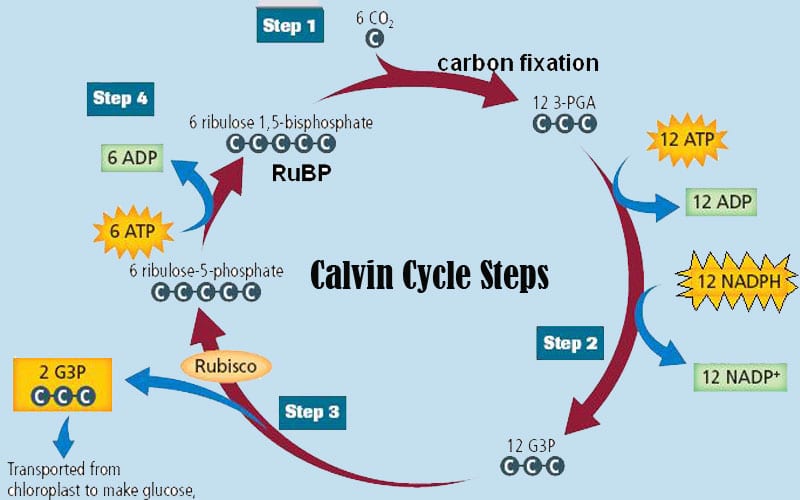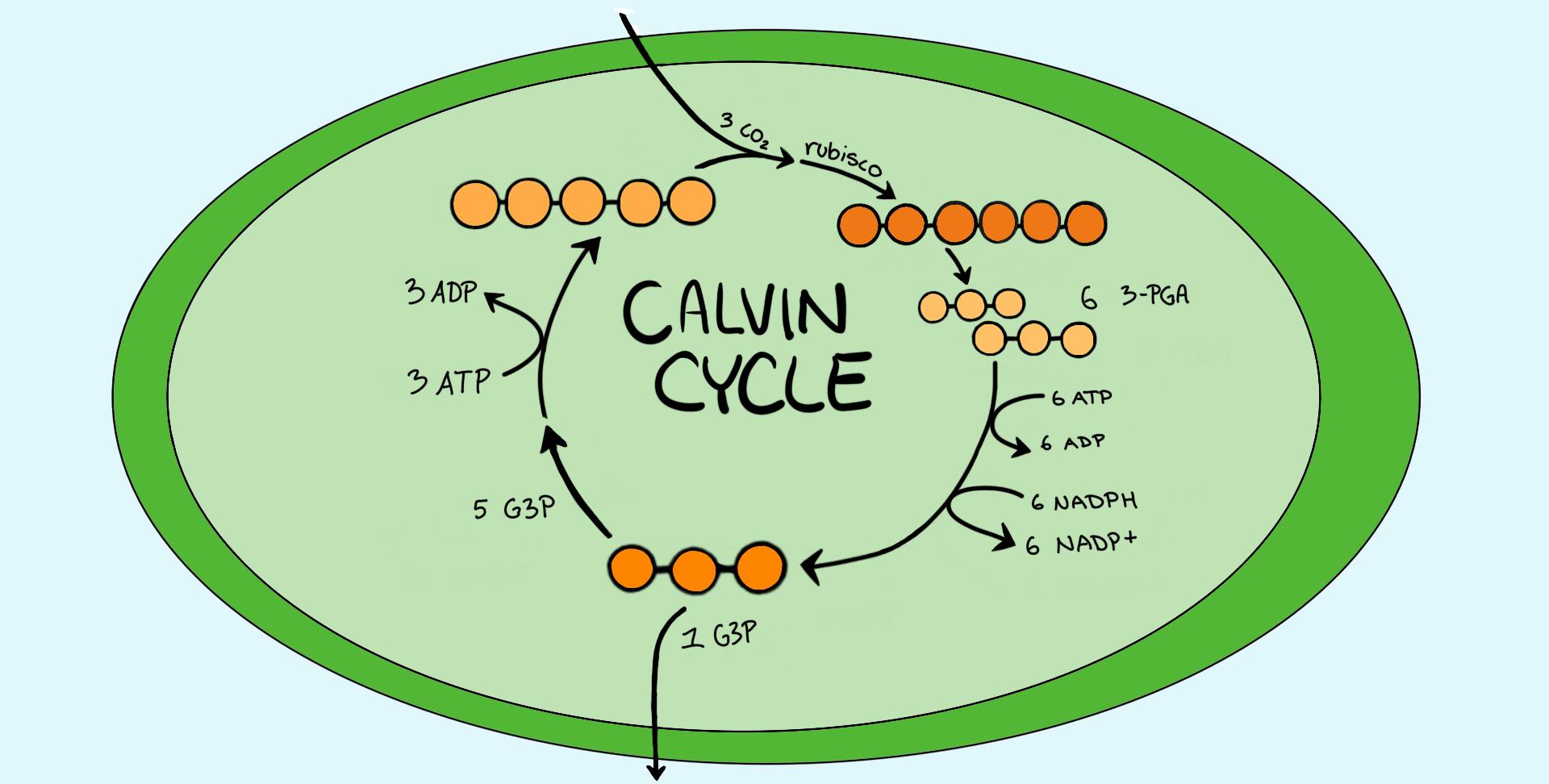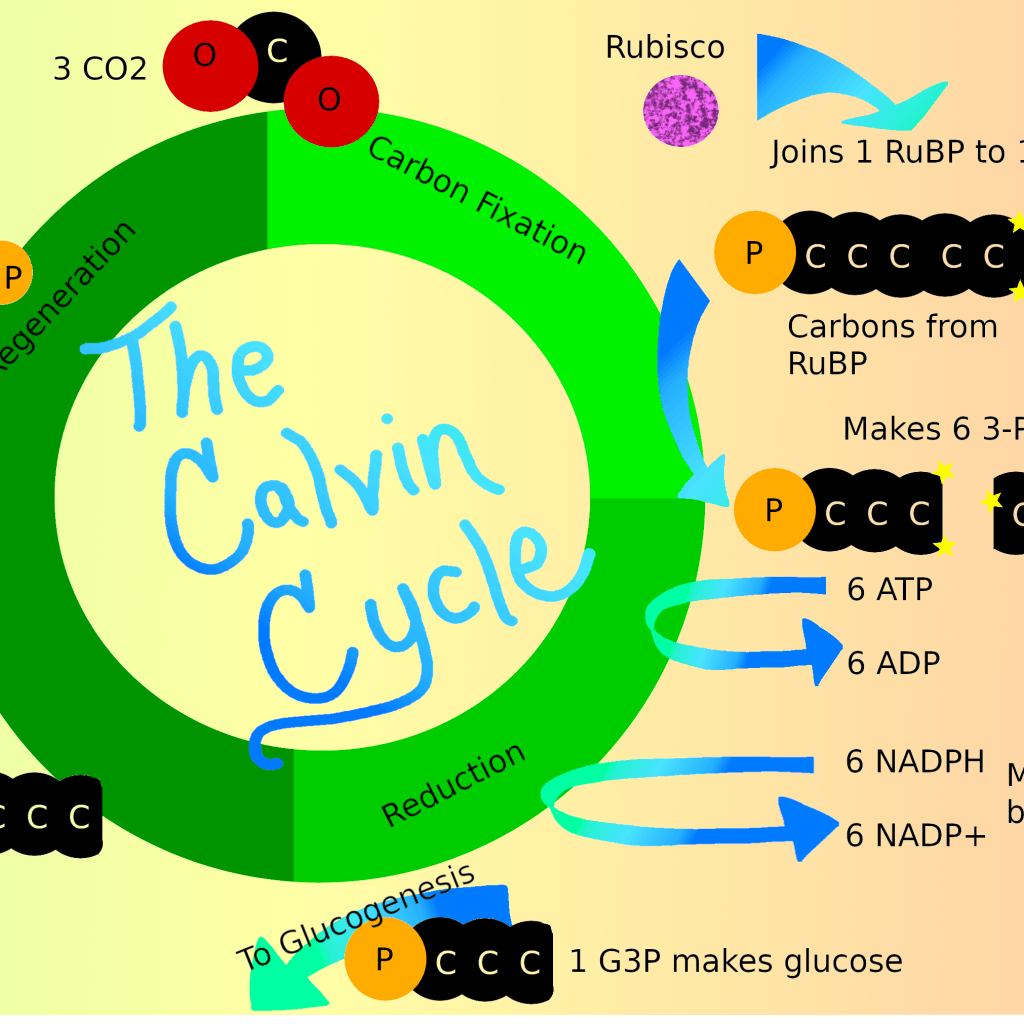Is the Calvin Cycle in the thylakoid or stroma? This question is a fundamental one for understanding photosynthesis, the process that powers life on Earth. Photosynthesis is a two-part process, with the first part, the light-dependent reactions, taking place in the thylakoid membrane within chloroplasts. But where does the Calvin Cycle, the second part of photosynthesis, occur? Let’s dive into the chloroplast and uncover the location of this crucial process.
Chloroplasts are the green organelles within plant cells where photosynthesis occurs. They have a complex structure, with a double membrane surrounding an internal compartment called the stroma. Within the stroma are stacks of flattened sacs called thylakoids, which are interconnected and form a third membrane system. The thylakoid membrane is where the light-dependent reactions of photosynthesis take place, but the Calvin Cycle, where carbon dioxide is converted into sugar, happens in the stroma.
Introduction to Photosynthesis
Photosynthesis is a vital process that sustains life on Earth. It is the process by which plants, algae, and some bacteria convert light energy from the sun into chemical energy in the form of glucose, a type of sugar. This chemical energy is then used to fuel the growth and development of these organisms. Photosynthesis also releases oxygen as a byproduct, which is essential for the survival of most living things.Photosynthesis occurs in two main stages: the light-dependent reactions and the Calvin cycle.
The light-dependent reactions capture light energy and convert it into chemical energy in the form of ATP and NADPH. These molecules are then used in the Calvin cycle to convert carbon dioxide into glucose.
The Role of Chloroplasts in Photosynthesis
Photosynthesis takes place in organelles called chloroplasts. Chloroplasts are found in the cells of plants and algae. They are responsible for capturing light energy and converting it into chemical energy. Chloroplasts have a unique structure that enables them to carry out photosynthesis efficiently.The chloroplast is surrounded by two membranes: the outer membrane and the inner membrane. The space between these two membranes is called the intermembrane space.
Inside the chloroplast is a third membrane system called the thylakoid membrane. The thylakoid membrane forms flattened sacs called thylakoids, which are stacked into structures called grana. The space inside the thylakoids is called the thylakoid lumen. Surrounding the grana is a fluid-filled region called the stroma.The thylakoid membrane contains chlorophyll, a pigment that absorbs light energy. When light energy is absorbed by chlorophyll, electrons are excited and move to a higher energy level.
These excited electrons are then used to generate ATP and NADPH in the light-dependent reactions. The stroma contains enzymes that are involved in the Calvin cycle.
The thylakoid membrane is where the light-dependent reactions occur, while the Calvin cycle takes place in the stroma.
The Light-Dependent Reactions
The light-dependent reactions of photosynthesis are the initial stages of this process, occurring within the thylakoid membranes of chloroplasts. These reactions harness light energy to produce ATP (adenosine triphosphate) and NADPH (nicotinamide adenine dinucleotide phosphate), which are essential energy carriers for the subsequent Calvin cycle.
Light Energy Capture and Chlorophyll
Chlorophyll, the green pigment found in chloroplasts, plays a crucial role in capturing light energy. Chlorophyll molecules absorb light energy, primarily in the red and blue regions of the visible spectrum, while reflecting green light, giving plants their characteristic color. This absorbed light energy excites electrons within the chlorophyll molecule, initiating the process of photosynthesis.
The Thylakoid Membrane and Photosystems
The thylakoid membrane, a complex internal membrane system within chloroplasts, is the site of the light-dependent reactions. This membrane contains embedded protein complexes known as photosystems, which are crucial for capturing light energy and converting it into chemical energy.Photosystem II (PSII) is the first photosystem involved in the light-dependent reactions. It absorbs light energy, which excites electrons in chlorophyll molecules.
These excited electrons are then passed along an electron transport chain, a series of protein complexes embedded in the thylakoid membrane.As electrons move through the electron transport chain, they release energy, which is used to pump protons (H+) from the stroma, the fluid-filled space outside the thylakoid membranes, into the thylakoid lumen, the space inside the thylakoid membranes. This proton gradient creates a potential energy difference across the thylakoid membrane, driving the production of ATP.Photosystem I (PSI) is the second photosystem involved in the light-dependent reactions.
It absorbs light energy, which further excites electrons that have already been passed through the electron transport chain. These excited electrons are then used to reduce NADP+ to NADPH, a crucial electron carrier for the Calvin cycle.
ATP Production
The flow of protons from the stroma into the thylakoid lumen creates a proton gradient, a difference in proton concentration across the thylakoid membrane. This gradient represents potential energy, similar to a dam holding back water.ATP synthase, an enzyme embedded in the thylakoid membrane, utilizes this proton gradient to produce ATP. As protons flow back across the membrane through ATP synthase, the enzyme uses the energy to convert ADP (adenosine diphosphate) and inorganic phosphate (Pi) into ATP.
This process is known as chemiosmosis, where the energy of a proton gradient is used to drive ATP synthesis.
NADPH Production
Photosystem I, after absorbing light energy, passes its excited electrons to a series of electron carriers, ultimately reducing NADP+ to NADPH. NADPH, a powerful reducing agent, carries high-energy electrons and will be used in the Calvin cycle to reduce carbon dioxide into sugars.
The Calvin Cycle: Is The Calvin Cycle In The Thylakoid Or Stroma

The Calvin cycle, also known as the Calvin-Benson cycle, is a series of biochemical reactions that take place in the stroma of chloroplasts, the site of photosynthesis in plants. This cycle is the central part of photosynthesis, where carbon dioxide from the atmosphere is converted into glucose, a sugar that provides energy for the plant.
Carbon Fixation
The Calvin cycle begins with the fixation of carbon dioxide into an organic molecule. This step is catalyzed by the enzyme RuBisCo (ribulose-1,5-bisphosphate carboxylase/oxygenase), which is one of the most abundant enzymes on Earth.
- RuBisCo combines carbon dioxide with a five-carbon sugar called ribulose-1,5-bisphosphate (RuBP), forming an unstable six-carbon compound that quickly breaks down into two molecules of 3-phosphoglycerate (3-PGA), a three-carbon compound.
Reduction
The next step in the Calvin cycle is the reduction of 3-PGA into glyceraldehyde-3-phosphate (G3P), a three-carbon sugar. This reduction requires energy from ATP and reducing power from NADPH, both of which are produced in the light-dependent reactions.
- First, 3-PGA is phosphorylated by ATP, forming 1,3-bisphosphoglycerate.
- Then, 1,3-bisphosphoglycerate is reduced by NADPH, forming G3P.
Regeneration of RuBP
For every six molecules of carbon dioxide that enter the Calvin cycle, only one molecule of G3P is produced as a net gain. The remaining five molecules of G3P are used to regenerate RuBP, the starting molecule for the cycle.
- This regeneration process involves a series of complex reactions that require ATP and rearrange the carbon atoms of G3P to form RuBP.
Key Enzymes in the Calvin Cycle
The Calvin cycle involves several key enzymes, each playing a specific role in the process:
- RuBisCo: This enzyme catalyzes the first step of the Calvin cycle, the fixation of carbon dioxide into RuBP. It is highly specific for carbon dioxide but can also bind oxygen, leading to photorespiration, a process that reduces photosynthetic efficiency.
- Phosphoglycerate kinase: This enzyme catalyzes the phosphorylation of 3-PGA to 1,3-bisphosphoglycerate.
- Glyceraldehyde-3-phosphate dehydrogenase: This enzyme catalyzes the reduction of 1,3-bisphosphoglycerate to G3P.
- Triose phosphate isomerase: This enzyme interconverts G3P and dihydroxyacetone phosphate (DHAP), which are both three-carbon sugars.
- Fructose-1,6-bisphosphatase: This enzyme catalyzes the hydrolysis of fructose-1,6-bisphosphate to fructose-6-phosphate.
- Sedoheptulose-1,7-bisphosphatase: This enzyme catalyzes the hydrolysis of sedoheptulose-1,7-bisphosphate to sedoheptulose-7-phosphate.
- Ribulose-5-phosphate kinase: This enzyme catalyzes the phosphorylation of ribulose-5-phosphate to RuBP.
Utilization of ATP and NADPH
The Calvin cycle utilizes the ATP and NADPH produced in the light-dependent reactions to power the reduction of 3-PGA to G3P.
- ATP provides the energy required for the phosphorylation reactions, while NADPH provides the reducing power needed for the reduction of 1,3-bisphosphoglycerate to G3P.
Location of the Calvin Cycle

The Calvin cycle, the second stage of photosynthesis, is a series of biochemical reactions that occur in the stroma of the chloroplast. This location is crucial for the efficient operation of the Calvin cycle, and its separation from the thylakoid membrane ensures the proper functioning of both photosynthetic stages.The Calvin cycle takes place in the stroma because it requires the products of the light-dependent reactions, which are generated in the thylakoid membrane.
These products include ATP (adenosine triphosphate), a high-energy molecule, and NADPH (nicotinamide adenine dinucleotide phosphate), a reducing agent. The stroma provides the necessary environment for the Calvin cycle to utilize these products efficiently.
Stroma and Thylakoid Lumen: A Comparative Analysis
The stroma and thylakoid lumen, the space within the thylakoid membrane, differ significantly in their environments, making the stroma the ideal location for the Calvin cycle.
- The stroma is a relatively high pH environment, with a pH of around 8, while the thylakoid lumen has a low pH, around 5. This pH difference is essential for the light-dependent reactions, which utilize the proton gradient across the thylakoid membrane to generate ATP. However, the low pH of the thylakoid lumen would be detrimental to the Calvin cycle’s enzymatic reactions.
- The stroma is rich in enzymes required for the Calvin cycle, such as RuBisCo (ribulose-1,5-bisphosphate carboxylase/oxygenase), the enzyme responsible for fixing carbon dioxide. The thylakoid lumen, on the other hand, contains enzymes involved in the light-dependent reactions.
- The stroma contains a high concentration of carbon dioxide, which is the primary substrate for the Calvin cycle. The thylakoid lumen has a lower concentration of carbon dioxide, making it unsuitable for the Calvin cycle.
The Calvin cycle is a series of reactions that occur in the stroma of the chloroplast. It utilizes the products of the light-dependent reactions, ATP and NADPH, to convert carbon dioxide into glucose.
Importance of the Calvin Cycle

The Calvin cycle, also known as the Calvin-Benson cycle, is a crucial metabolic pathway in photosynthesis. It takes place in the stroma of chloroplasts and is responsible for converting carbon dioxide into glucose, the primary energy source for most organisms. This cycle is vital for life on Earth, playing a critical role in carbon fixation, plant growth, and the global carbon cycle.
The Calvin Cycle’s Role in Glucose Production
The Calvin cycle is the primary mechanism for producing glucose, the primary energy source for most organisms. The cycle uses energy stored in ATP and NADPH, produced during the light-dependent reactions of photosynthesis, to convert carbon dioxide into glucose. This process involves a series of enzymatic reactions that fix carbon dioxide, reduce it to a sugar, and regenerate the starting molecule for the cycle.
The overall equation for the Calvin cycle is:
6 CO2 + 18 ATP + 12 NADPH + 12 H 2O → C 6H 12O 6 + 18 ADP + 18 P i + 12 NADP + + 6 H +
This equation demonstrates how carbon dioxide is incorporated into an organic molecule, ultimately producing glucose, which serves as the fundamental building block for various cellular processes.
The Calvin Cycle’s Role in Carbon Fixation, Is the calvin cycle in the thylakoid or stroma
Carbon fixation is the process of converting inorganic carbon dioxide into organic compounds. The Calvin cycle is the primary pathway for carbon fixation in plants, algae, and some bacteria. The cycle captures carbon dioxide from the atmosphere and incorporates it into a five-carbon sugar molecule called ribulose 1,5-bisphosphate (RuBP). This process is catalyzed by the enzyme Rubisco, which is one of the most abundant enzymes on Earth.
The incorporation of carbon dioxide into RuBP initiates a series of reactions that eventually lead to the formation of glucose.
The Calvin Cycle’s Role in Plant Growth and Development
The Calvin cycle is essential for plant growth and development. Glucose produced by the Calvin cycle is used as a source of energy for various metabolic processes, including cell division, growth, and the synthesis of complex molecules like proteins, lipids, and nucleic acids. The cycle also provides the building blocks for the synthesis of cellulose, the primary structural component of plant cell walls.
This process is critical for plant growth and development, enabling plants to produce biomass and contribute to the global ecosystem.
So, the answer is clear: the Calvin Cycle takes place in the stroma, not the thylakoid membrane. This location makes sense because the Calvin Cycle requires the products of the light-dependent reactions, ATP and NADPH, which are produced in the thylakoid membrane and then diffuse into the stroma. The stroma also provides a suitable environment for the enzymes involved in the Calvin Cycle to function properly.
Understanding the location of the Calvin Cycle is crucial for comprehending the intricate dance of photosynthesis, a process that sustains life on our planet.
Top FAQs
Why is the Calvin Cycle important?
The Calvin Cycle is vital because it’s the process that converts carbon dioxide into glucose, the primary energy source for most organisms. It also plays a crucial role in carbon fixation, removing carbon dioxide from the atmosphere and incorporating it into organic molecules.
What are the key enzymes involved in the Calvin Cycle?
The Calvin Cycle involves a number of key enzymes, including RuBisCO (ribulose-1,5-bisphosphate carboxylase/oxygenase), which catalyzes the first step of carbon fixation, and phosphoribulokinase, which regenerates RuBP, the starting molecule of the cycle.
What is the difference between the thylakoid lumen and the stroma?
The thylakoid lumen is the space inside the thylakoid membrane, while the stroma is the fluid-filled region surrounding the thylakoids. The thylakoid lumen has a higher concentration of protons than the stroma, which is important for generating ATP in the light-dependent reactions. The stroma has a higher concentration of carbon dioxide, which is necessary for the Calvin Cycle.






